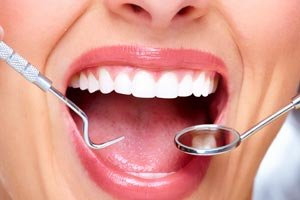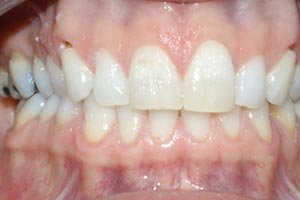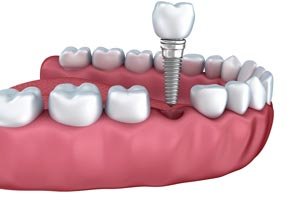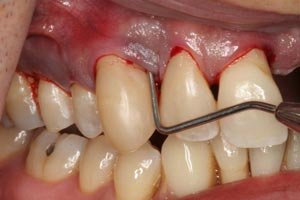Dental Implants
A dental implant is an artificial tooth root that is surgically anchored into your jaw DENTAL IMPLANTS are the better solution for every case. These are root like device, a post, made of Titanium, screw-shaped threaded cylinders that are surgically placed into the jawbone by the chosen oral surgeon in the upper (Maxillary) and/or lower (Mandibular) arches of the mouth. They are used to replace one or many missing teeth, or to stabilize dentures. Titanium is an inert metal that is capable of creating a very tight bond with bone. The prosthesis (artificial tooth or teeth) is/are then attached to the post.
What are the types of Dental Implants?
There are several types of dental implants available. The endosteal and the subperiosteal implants find more recognition and acceptability by ADA. An important factor for selection is to determine whether your jawbone can adequately support the implant. Most dental implants placed today are endosteal root form fixtures (similar to a man-made tooth root).
What is the Dental Implants Used For?
There are two basic uses for Dental Implants:
1. As an artificial root for a single tooth replacement.
2. As anchors for a fixed or removable prosthesis to replace multiple teeth.
What Are the Benefits of Dental Implants?
The only next best alternative to the loss of your natural teeth, are the dental implants. In looks the implants are as good as your natural teeth. One important benefit of implants is that they slow the shrinking of bone and gum tissue from the area of the missing tooth, thus preventing premature aging.
- Of people between the ages of 18 and 65, a greater percentage is missing at least one tooth.
- Dental implants are the most advanced tooth replacement system ever devised and in use for many years now.
- More than nine out of ten implants last longer than 15 years.
- They are cleaned and flossed just like natural teeth.
- Dental implants never develop decay.
- Dental implants never require root canals.
- Dental implants preserve the jawbone, which can prevent premature aging.
- No one can be disqualified for implant treatment solely because of the age; some patients receive implant treatment when they are in the niceties of nineties!
How Are Dental Implants Placed?
The procedure begins with a thorough evaluation of the patient's medical and dental history. A full clinical examination of the entire mouth and missing tooth area is done. The clinical exam should also include any specific CT scan, OPG X-rays and dental imaging. After the patient has been assessed, a comprehensive treatment plan is devised and patient so informed for consent. After the patient is in affirmation, implants are surgically placed in the jawbone under local anesthesia.
Traditionally, a dental surgeon, like an Oral Surgeon or a Prosthodontist or a Periodontist, performs the surgical component. A general dentist or laboratory technician performs the restorative component. However, as implant dentistry has become more sophisticated, sometimes a dentist who specializes in restorative dentistry conducts the entire procedure.
The length of the healing time is based on the quality and quantity of bone, as well as the type of implant placed. Implants placed in the upper jaw need six months to attach to the bone (called ‘osseointegration’) and implants placed in the lower jaw need four months. After that, the tooth can be attached on top and the whole thing is done. Once the natural process called osseointegration (bone formation around the implants) is achieved in a few months, the Implantologist can fasten the crown, bridges or overdenture to this artificial root (implants).
Step One: The gum is gently folded back and a space is prepared for the implant to be placed.
Step Two: The dental implant "anchor" is put into place.
Step Three: In this a temporary cap is placed on the implant and the gum tissue is repositioned around the implant. The implant is then left alone for several months so the bone can attach to the implant and create a secure anchor.
Restorative Phase:
Step One: After the implant has had a chance, after due gestation (osseointegration), to attach to the bone tissue, the temporary cap is removed from the anchor and a post is attached to the anchor.
Step Two: The implant is now ready for the prosthesis. An impression is taken of the implant and the appropriate prosthesis (crown, bridge or overdenture) is made.
Step Three: The prosthesis is then attached to the implant(s).
What number of Implants can be placed?
This is a question that should be determined during the treatment plan. In cases where there are multiple missing teeth, or where the patient has previously had dentures, multiple implants are placed in the mouth to allow for implant-supported crowns or bridges, ball abutment retained overdenture, and/or bar-supported overdenture.
Other decisive factor for the number of implants needed for success is the quality and quantity of the patient's bone. A good rule-of-thumb is to place one implant for each tooth replaced. Placing enough implants to restore teeth is vitally important to the long-term success of the restoration. If the number of implants is limited due to financial constraints of the patient, then the implant treatment should be avoided or the type of restoration must be altered.
Considering a Dental Implant?
If you are considering a dental implant, contact our office for an evaluation appointment. The oral surgeon on our panel will perform an evaluation to determine whether you are a good candidate for a dental implant. Generally, if your jawbone ridges are in good shape with healthy oral tissues, you are a good candidate for implants. If you are declared a good candidate for an implant, the chosen dentist will provide you with further information to help you decide.
Implant placement is a minimal invasive, atraumatic and painless procedure that is done under local anesthesia in a normal dental chair unit. The procedure doesn’t take much time and there are no restrictions in maintaining stress less routine activities.
The picture below is a good example of permanently implanting a synthetic tooth to fill a gap, while tooth-coloured fillings substantially improve the aesthetics of your smile.
Advanced Procedures:
In selected cases implants can be immediately placed after tooth extraction like in anterior trauma cases, and in cases with retained deciduous tooth / teeth etc.
Sometimes, patient may have less available bone width and height necessary for implant placement due to resorbed ridges, ballooning of maxillary sinus, traumatic bone loss etc. In such cases implant placement is possible by various bone augmentation procedures like sinus lift (direct and indirect), chin graft, ileac crest graft, grafting by alloplastic materials, nerve repositioning etc
Earlier removable partial dentures (R.P.D) were prevalent and to support the artificial teeth plastic like material (acrylic) were used. It creates lots of inconvenience by hindering movement of tongue, thus leading to speech problem and being unhygienic because of food deposition.
The fixed partial dentures (F.P.D) are very convenient comparable to removable partial dentures but for F.P.D healthy and firm teeth are needed to get the support. The quite unfortunate option is that the normal healthy teeth are trimmed for the crown placement. But a person can’t have a fixed prosthesis when there are no firm teeth present on the posterior aspect for supporting the F.P.D.
Similarly wearing a complete denture (C.D.) puts the patients to long learning curve how to keep the dentures in the mouth. The denture got the rocking tendency due to tongue movements and is very difficult when resorbed ridges are there.
IMPLANTS MAY NOT BE PLACED IN:
- Patients on certain medicaments like corticosteroids.
- Patients with bone disorders like fibrous dysphasia etc.
- Patients with hematological disorders like hemophilia.
- Patients with missing the tooth or teeth for a long time (more than five years) and there is not enough bone to put the implant into.
- Having active infections like tuberculosis, temporal flu etc.
- Active lesions like cyst, abscess, etc.
- Patients with endocrine disorders like uncontrolled diabetes, pituitary and adrenal insufficiency, hypothyroidism etc.
- Anatomical restrictions like insufficient space for implant placement.
- Social restrictions like psychological disorders.
- Chain smokers.
Merits and Demerits:
- Perfect for aesthetic demands.
- Implants maintain, or realign, facial structure and profile, and preserve bone.
- Implants help to preserve adjacent natural teeth.
- Implants look, feel, and function like natural teeth.
- Implants are more durable, firm and can take 8 times extra load than natural tooth.
- Implants are cost effective when taking into account the functioning life of the implant.
- It involves minimal invasive and placed at the edentulous site without touching natural tooth structure.
- Floating dentures can be firmly secured.
- On the demerit side, these are costly compared to conventional ones.
Family Dentistry, You and your family deserve quality family dental care. Shankar Dental Clinic is the foremost clinic facilitating dental tourism in India with a most caring, friendly team of dental professionals on the panel committed to providing a comfortable dental experience for your entire family, with a combine of anywhere dentistry and tourism in India. Our goal is to provide the best and most affordable dental care possible for you and your family in a compassionate, caring environment. We want to help you maintain your oral hygiene in a way that will keep your teeth and mouths healthy for a lifetime.













